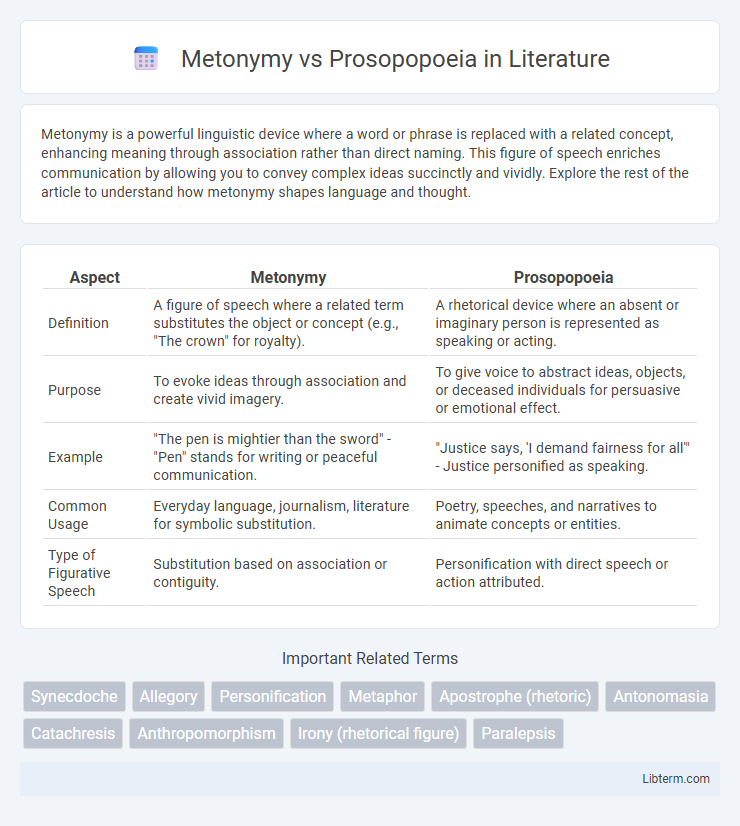Metonymy is a powerful linguistic device where a word or phrase is replaced with a related concept, enhancing meaning through association rather than direct naming. This figure of speech enriches communication by allowing you to convey complex ideas succinctly and vividly. Explore the rest of the article to understand how metonymy shapes language and thought.
Table of Comparison
| Aspect | Metonymy | Prosopopoeia |
|---|---|---|
| Definition | A figure of speech where a related term substitutes the object or concept (e.g., "The crown" for royalty). | A rhetorical device where an absent or imaginary person is represented as speaking or acting. |
| Purpose | To evoke ideas through association and create vivid imagery. | To give voice to abstract ideas, objects, or deceased individuals for persuasive or emotional effect. |
| Example | "The pen is mightier than the sword" - "Pen" stands for writing or peaceful communication. | "Justice says, 'I demand fairness for all'" - Justice personified as speaking. |
| Common Usage | Everyday language, journalism, literature for symbolic substitution. | Poetry, speeches, and narratives to animate concepts or entities. |
| Type of Figurative Speech | Substitution based on association or contiguity. | Personification with direct speech or action attributed. |
Introduction to Metonymy and Prosopopoeia
Metonymy is a figure of speech where one word or phrase substitutes for another with which it is closely associated, such as "the crown" representing monarchy. Prosopopoeia involves giving a voice to inanimate objects, abstract concepts, or absent persons by speaking for them, often used to dramatize or personify. Understanding these rhetorical devices enhances the grasp of literary techniques that enrich expression and meaning in language.
Defining Metonymy: Meaning and Use
Metonymy is a figure of speech where a word or phrase is substituted with another closely related term, such as using "the crown" to represent royal authority. Its meaning hinges on a direct association between concepts, like part-whole relationships or symbolic connections, making it a powerful tool in language for concise and vivid expression. Commonly used in literature, rhetoric, and everyday communication, metonymy enriches meaning by invoking related ideas without explicitly naming them.
Prosopopoeia Explained: Giving Voice to the Inanimate
Prosopopoeia is a rhetorical device that gives voice or consciousness to inanimate objects, abstract ideas, or absent entities, allowing them to speak or express human emotions and thoughts. Unlike metonymy, which substitutes one term for another related concept, prosopopoeia personifies non-human elements to enhance emotional impact and engagement in literature or speech. This technique enriches narrative depth by animating the inanimate, making abstract or lifeless subjects accessible and vivid for the audience.
Historical Origins of Metonymy and Prosopopoeia
Metonymy, originating in ancient Greek rhetoric, involves substituting a related term to represent an object or concept, rooted in classical literary traditions such as Aristotle's Poetics. Prosopopoeia also stems from classical antiquity, where it was used in speeches and poetry to personify abstract ideas or inanimate objects, often found in Roman and Greek literature. Both rhetorical devices served as powerful tools in historical oratory and literature to create vivid imagery and persuasive effects.
Key Differences Between Metonymy and Prosopopoeia
Metonymy is a figure of speech where a related term or attribute substitutes for the thing meant, such as "the crown" representing royalty, emphasizing association rather than personification. Prosopopoeia involves giving voice or speech to an abstract concept, inanimate object, or absent person, effectively personifying the entity to express thoughts or feelings. The key difference lies in metonymy's reliance on symbolic substitution, while prosopopoeia directly animates an entity to speak or act.
Linguistic Functions in Literary Analysis
Metonymy functions as a linguistic device where a related term replaces the object or concept it signifies, enriching textual imagery and contributing to thematic development in literary analysis. Prosopopoeia, a form of personification, attributes speech or actions to abstract ideas or inanimate objects, facilitating deeper emotional engagement and narrative voice exploration. Both devices enhance interpretive layers by embedding symbolic meaning and animating non-human entities, crucial for deciphering authorial intent and stylistic nuance.
Examples of Metonymy in Literature and Speech
Metonymy involves substituting a related term for the thing meant, such as using "the crown" to represent royalty or "the White House" for the U.S. president. In literature, Shakespeare often used metonymy, as in "lend me your ears" to mean listening attentively. In everyday speech, phrases like "the pen is mightier than the sword" exemplify metonymy by using "pen" for writing and "sword" for military force.
Examples of Prosopopoeia Across Genres
Prosopopoeia, a figure of speech where an abstract concept, inanimate object, or absent person is given speech or voice, appears vividly across literature, drama, and poetry. In Shakespeare's "Macbeth," Lady Macbeth invokes night as a silent conspirator, embodying prosopopoeia by giving night the ability to hear and act, while in classical poetry, seasons and elements often address humanity as if sentient beings. Modern genres like political speeches and advertisements frequently use prosopopoeia by personifying nations, corporations, or ideals to evoke emotional connections and convey persuasive narratives.
Effects on Audience Interpretation and Engagement
Metonymy enhances audience interpretation by creating connections between related concepts, allowing for quicker comprehension and a more vivid mental image through the substitution of a closely associated term. Prosopopoeia actively engages the audience by personifying abstract ideas or inanimate objects, making them relatable and eliciting emotional responses through direct speech or attributed human traits. Both rhetorical devices deepen engagement, but while metonymy sharpens interpretative clarity, prosopopoeia intensifies emotional involvement.
Conclusion: Choosing Between Metonymy and Prosopopoeia
Choosing between metonymy and prosopopoeia depends on the desired rhetorical effect and the context of communication. Metonymy substitutes a related term to evoke deeper meaning, ideal for concise symbolism, while prosopopoeia involves personification or speaking on behalf of an abstract idea, enhancing emotional connection. Understanding the nuances of these figures of speech ensures precise and impactful expression in literary and persuasive writing.
Metonymy Infographic

 libterm.com
libterm.com